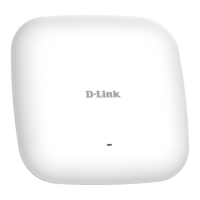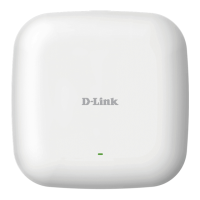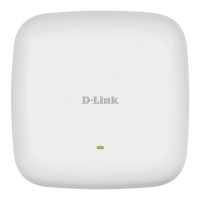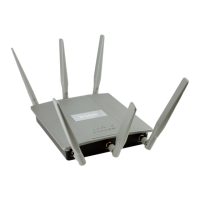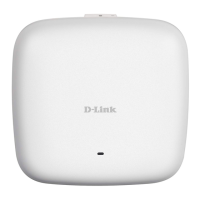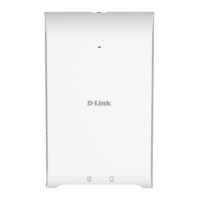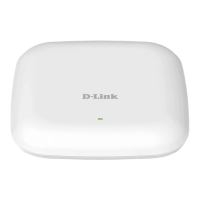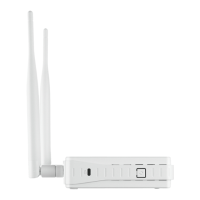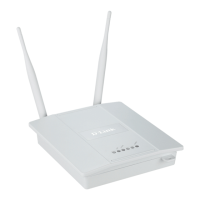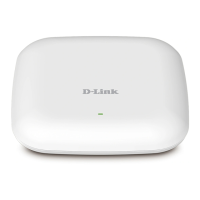
Do you have a question about the D-Link DAP-2662 and is the answer not in the manual?
| 2.4 GHz | Yes |
|---|---|
| Frequency band | 2.4, 5 GHz |
| Transmitting power | 26 dBmW |
| Networking standards | IEEE 802.11a, IEEE 802.11ac, IEEE 802.11b, IEEE 802.11g, IEEE 802.11n, IEEE 802.3af |
| Ethernet LAN data rates | 10, 100, 1000 Mbit/s |
| Maximum data transfer rate | 1200 Mbit/s |
| Maximum data transfer rate (5 GHz) | 867 Mbit/s |
| Maximum data transfer rate (2.4 GHz) | 300 Mbit/s |
| Security algorithms | - |
| Number of SSID supported | 16 |
| WAN connection | Ethernet (RJ-45) |
| USB 2.0 ports quantity | USB 2.0 ports have a data transmission speed of 480 Mbps, and are backwards compatible with USB 1.1 ports. You can connect all kinds of peripheral devices to them. |
| Ethernet LAN (RJ-45) ports | 1 |
| Antenna type | Internal |
| Antennas quantity | 2 |
| Antenna gain level (max) | 3.8 dBi |
| Placement | Ceiling, Table, Wall |
| Product color | White |
| Number of products included | 1 pc(s) |
| Package depth | 248 mm |
| Package width | 208 mm |
| Package height | 73 mm |
| Package weight | 390 g |
| Pallet width | 1100 mm |
| Pallet length | 1200 mm |
| Pallet height (air) | 2011 mm |
| Pallet gross weight (air) | 174000 g |
| Quantity per pallet (air) | 420 pc(s) |
| Shipping (inner) case width | 383 mm |
| Shipping (inner) case height | 268 mm |
| Shipping (inner) case length | 431 mm |
| Shipping (inner) case weight | 4000 g |
| Shipping (inner) case net weight | 3900 g |
| Number of cartons per pallet (air) | 42 pc(s) |
| Quantity per shipping (inner) case | 10 pc(s) |
| Harmonized System (HS) code | 85176990 |
| Width | - mm |
|---|
Overview of D-Link's centralized management solution for SMB networks.
Highlights of the Nuclias Connect management software features.
Lists the items included in the DAP-2662 package.
Specifies the hardware and software requirements for using the DAP-2662.
Describes the status indicators on the access point.
Details the physical ports and connectors on the access point.
Explains methods for powering the DAP-2662 access point.
Illustrates the basic setup process for the access point.
Guides users through configuring system time, password, and daylight saving.
Displays current device status, firmware, and network parameters.
Configures basic wireless settings for the access point.
Sets up the access point to bridge multiple wireless networks.
Configures the access point to connect multiple wireless networks.
Configures the access point to act as a wireless network adapter.
Explains WEP encryption and its variations.
Details WPA and WPA2 security protocols and modes.
Configures how the device obtains an IP address (DHCP or Static).
Options to enable or configure IPv6 settings.
Configures wireless signal and hosting parameters.
Selects the operating frequency band (2.4GHz or 5GHz).
Defines supported client combinations for wireless operation.
Sets the base transfer rate for wireless adapters.
Configures beacon packets for network synchronization.
Sets the Delivery Traffic Indication Message interval.
Enables airtime fairness to regulate downlink airtime.
Configures steering clients to 5GHz or 2.4GHz bands.
Limits the number of users accessing the device.
Enables support for multiple SSIDs on the access point.
Defines the Service Set Identifier (network name).
Controls whether the SSID is broadcasted.
Configures security settings for each SSID.
Sets the priority level for each SSID.
Displays the current VLAN configurations.
Shows details of ports and their VLAN assignments.
Configures new VLANs or modifies existing ones.
Enables or disables VLAN status.
Configures automatic assignment of Port VLAN Identifiers.
Selects the wireless band for intrusion detection.
Initiates a scan of the wireless network.
Manages detected access points by category.
Configures scheduling rules for wireless features.
Sets up a username for RADIUS authentication.
Sets up a password for RADIUS authentication.
Enables or disables the RADIUS account.
Displays the list of configured RADIUS accounts.
Enables protection against ARP spoofing attacks.
Enables or disables bandwidth optimization.
Configures the downlink bandwidth limit.
Configures the uplink bandwidth limit.
Selects the type of bandwidth allocation rule.
Enables the Hotspot 2.0 feature.
Configures OSU Server-only authenticated network.
Enables cross connection between clients.
Enables peer-to-peer connections.
Configures downstream group addressed forwarding.
Enables proxy ARP functionality.
Enables Layer 2 Traffic Inspection and Filtering.
Enables the interworking function for Hotspot 2.0.
Specifies the type of network.
Enables or disables internet access for the network.
Enables additional steps for access.
Indicates emergency services availability.
Specifies the venue group.
Specifies the venue type.
Specifies the venue name.
Identifies a service provider network.
Shows the status of the access point's WAN connection.
Configures symmetric WAN link status.
Sets WAN capacity status.
Sets the downlink speed for WAN metrics.
Sets the uplink speed for WAN metrics.
Identifies unsecured network status.
Identifies IP address version and type used.
Lists domain names for the entity operating the AP.
Identifies service providers for roaming.
Lists available NAI realms.
Identifies 3GPP cellular networks.
Identifies IP protocol and port availability.
Identifies the Hotspot venue operator name.
Indicates support for QoS mapping.
Specifies the SSID for accessing the OSU server.
Specifies the URI of the OSU Server.
Lists preferred encoding methods for the OSU server.
Selects the configuration set to use for OSU.
Selects the language for OSU.
Specifies names for OSU friendly display.
Specifies the OSU Network Access Identifier.
Selects the service description language.
Selects the icon language for OSU.
Configures captive portal settings for web redirection.
Configures username/password authentication for clients.
Configures passcode authentication for clients.
Configures remote RADIUS authentication for clients.
Configures LDAP authentication for clients.
Configures POP3 authentication for clients.
Uploads custom login pages from the local drive.
Manages login page styles for SSIDs.
Enters MAC addresses for the bypass list.
Uploads a MAC bypass list file.
Downloads and saves the MAC bypass list.
Configures dynamic IP address assignment settings.
Configures static IP address assignment settings.
Displays current DHCP dynamic and static IP address assignments.
Configures Wireless MAC Access Control List for security.
Enables or disables IP filtering.
Enters IP address or network address for filtering.
Manages link integrity for wireless segments.
Controls data flow from Ethernet to wireless devices.
Manages inter-station communication.
Customizes downlink and uplink bandwidth rates.
Enables Quality of Service for traffic prioritization.
Sets downlink bandwidth for QoS.
Sets uplink bandwidth for QoS.
Creates traffic management rules.
Determines handling of unlisted client traffic.
Displays firmware version and device parameters.
Displays detailed information about connected wireless clients.
Displays WDS information for connected clients.
Displays transmitted and received Ethernet traffic counts.
Displays wireless network throughput and error statistics.
Displays system and network messages with timestamps.
Configures log server, notification, and types of logs.
Configures limits for administrator access.
Sets the device name, location, and MDNS name.
Configures user name and password for login.
Configures console access protocols and timeouts.
Enables or disables ping functionality.
Configures the status of device LEDs.
Selects the country for device localization.
Enables or disables DDP (Dynamic Data Protection).
Enables or disables Nuclias Connect functionality.
Updates the device firmware from a local file.
Uploads updated language packs for the device.
Uploads SSL certificates and keys.
Uploads or downloads the device configuration file.
Saves the current configuration to a local disk.
Uploads Nuclias Connect network configuration files.
Displays the current time and date.
Enables system time synchronization via NTP.
Specifies the NTP server IP address.
Selects the device's time zone.
Enables daylight saving time adjustments.
Sets specific dates for daylight saving.
Options to save, activate, or discard configurations.
Options to restart, factory reset, or clear settings.
Safely logs out from the web configuration.
Accesses help information for configuration options.
Restarts the DAP-2662 access point.
Resets the DAP-2662 to its factory default settings.
Clears the currently running language pack.
Provides brief descriptions of functions in basic settings.
Explains wireless configuration options.
Provides foundational information about wireless technology.
Offers guidelines for optimal wireless network installation.
Solves issues with accessing the device's web interface.
Provides steps to reset the device if the password is forgotten.
Guides users on how to find their IP address.
Explains how to manually assign a static IP address.
Lists the IEEE standards supported by the device.
Describes network management interfaces.
Lists supported security protocols.
Specifies the supported wireless frequency bands.
Details the power requirements for the device.
Describes the type and specifications of the antennas.
Lists the device's LED indicators.
Specifies operating and storage temperature ranges.
Specifies operating and storage humidity ranges.
Lists regulatory certifications for the device.
Provides the physical dimensions of the device.
Shows antenna radiation patterns for 2.4GHz ceiling mount.
Shows antenna radiation patterns for 2.4GHz wall mount.
Shows antenna radiation patterns for 5GHz ceiling mount.
Shows antenna radiation patterns for 5GHz wall mount.
